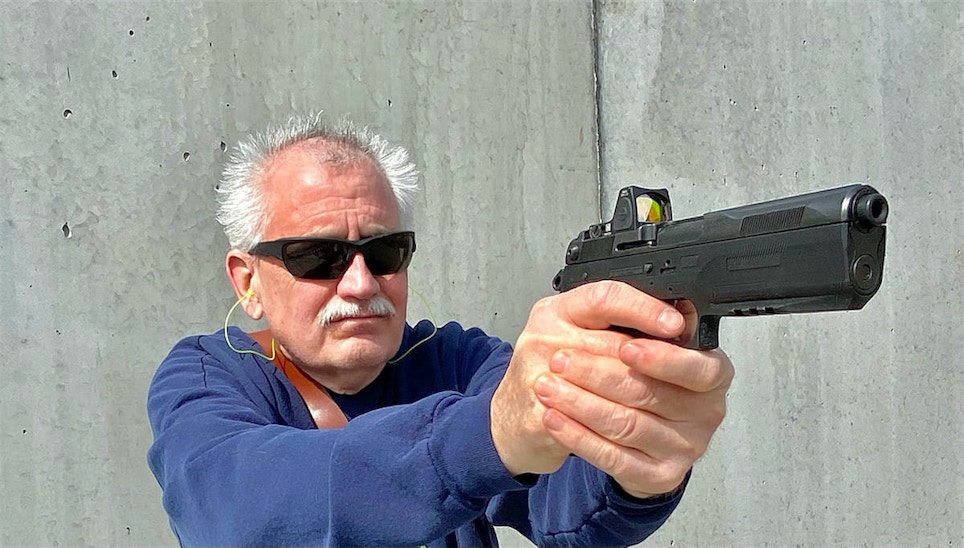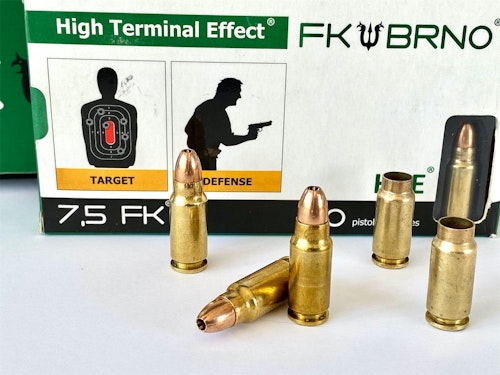At 10 and 25 yards with an FK BRNO PSD handgun chambered in 7.5 FK, the wild hogs didn’t stand a chance.
At 50 yards, the Bad Guy had a really bad day and was most likely down for the count.
And at 100 yards, well, I needed more time with the PSD — and additional ammo — but it was clear the pistol itself could do the job.
With manufacturing facilities in the Czech Republic city of Brno, FK BRNO launched the original version of this firearm in 2015 as the Field Pistol in the proprietary caliber of 7.5 FK. More recently, FK BRNO released the PSD (Police, Sport and Defense )Multi-Caliber Pistol.
The semi-automatic PSD is a polymer-framed single action, sporting a 5.3-inch barrel and a significant beaver tail at the rear. Lighter and much less expensive than the Field Pistol, the PSD and its older brother were originally designed for military and tactical applications. But the PSD definitely has self-defense and hunting capabilities, and as such should be a draw for a variety of customers.
Something Extra
The “7.5” in the 7.5 FK caliber refers to millimeters, making this essentially a 30-caliber pistol round with something extra.
That “extra” is the velocity at which the 7.5 FK bullet leaves the barrel of the PSD — 2,000 feet per second as recorded by my Caldwell Chronograph G2 from Brownells. That velocity makes the round and the PSD a kind of middle ground self-defense and hunting pistol in the 25- to 100-yard zone where a standard pistol might not be enough, but a carbine-size rifle may be too bulky for ease of use.
According to FK BRNO, “The 7.5 FK development was started initially to meet to a requirement by a private security provider that was operating in the Middle East. The problem that they were facing was that most engagements were taking place between 50 and 150 meters, and a lot of the times it was out of vehicles, and/or in urban areas.”
At those distances, the standard 9mm and 45 ACP sidearms were insufficient, and in vehicles the AR-style carbines were often too large to get on target quickly.
FK BRNO tackled this problem first by creating a cartridge along the following parameters: “accuracy of 10 cm [4 inch] rectangle group at 100 meters [110 yards], bullet caliber not less than 7.2mm [.280], velocity at 100 meters not less than 450 m/s [1475 fps], permanent wound cavity not less than 3.5 cm diameter x 35 cm length [1.4 inch x 14 inch] wearing full combat clothing at 100 meters [110 yards]. And Level 3A vest penetration capability at 100 meters. The Recoil force must not exceed that of the .45 ACP in a 1911 pistol.”
Of note, a Level 3A vest is a soft body armor vest capable of stopping most handgun rounds.
The result: the FK BRNO PSD firing the bottlenecked 7.5 FK caliber and round designed specifically to bridge the gap between standard handgun and carbine rifle calibers in terms of power, efficiency, range and accuracy.
The PSD and all other FK BRNO products are imported by FK BRNO US in Gainesville, Florida. The U.S. office sent me the PSD and two types of FK 7.5 ammunition:
The F5 for self-defense and hunting medium game. The 95-grain all copper bullet is built with a segmented nose designed to break off on impact and create a jagged 7mm meplat for a deep and ragged wound channel
S95 rounds for self-defense and target. Loaded with a 95-grain jacketed hollow point made by Sierra for FK BRNO, the bullet fairly explodes on impact to create a wide but much shallower wound channel than the F5 bullets.
Stretching Out
I began my testing of the PSD with the iron sights that came with the pistol, and accuracy was impressive. Once I got used to how the PSD handled, 1.0 to 1.5-inch groups with both varieties of ammunition were easy to achieve at 10 yards offhand. Recoil was about what I’d expect from a 1911 chambered in 10mm.
Those sights were rather small though, and I would be shooting longer distances, too, so I mounted a Trijicon RMR optic on the PSD. I simply removed the plate atop the rear of the slide, fitted the RMR into place, and tightened down the mounting screws.
A top selling point: The PSD slide is actually pre-cut and drilled to fit a wide variety of red-dot models, including those made by AmeriGlo, Leupold, Holosun, Riton and Vortex. The PSD includes various mounting screws to fit these different optics.
First, I zeroed the RMR at 12 yards from a rest using the F5 rounds. Then I shot the PSD offhand at the same distance. My best group here was done on a Birchwood Casey Darkotic target of a mutant-looking hog, placing six shots into a 1-inch group at the top of the nose, and purposely fired off shot #7 into the lower nose.
Then, it was time to stretch some PSD legs, so to speak.
Using the S95 ammunition, I started with a standard target at 25 yards and was able to peg groups of 2.5 inches without a problem, using a rest. Then I switched to the F5 ammunition for my “pig test.” This required a slight re-zeroing of the RMR as the different ammunition was shooting high.
Once zeroed, my best group on the 25-yard wild hog target was five shots to the head at 2.0 inches, with a sixth shot adding another inch (and what would’ve been a miss).
At 50 yards, I set up a bright yellow Birchwood Casey “Bad Guy” target. The thug was dressed in bright yellow and the larger target, at 23x35 inches, provided a nice sight picture for the RMR. Shooting from a rest, my initial shots were low, and I decided that I was jerking the trigger. But once I figured out my mechanics, I put five shots into the center mass at just a shade under 3 inches. In fact, four of those shots pegged in at just 2 inches.
As noted, FK BRNO rated the PSD as capable of a 4-inch group at 100 yards. I only had a dozen rounds of the F5 ammunition left by this point and shot off three rounds to determine what sort of drop the rounds had at this distance. Not much at all, it turned out.
So, shooting at a standard 8.5 x 11-inch piece of copy paper, I shot five rounds, paused a few minutes to let the gun cool, and then fired the last four rounds. My first five shots were all over the target area, which I put down to me getting used to the RMR and the pistol at this distance. But my last four shots came in at 6 inches.
As noted, my Caldwell Chronograph G2 measured both 7.5 FK rounds at 2,000 feet per second, with the muzzle of the PSD approximately 5 feet from the front of the chronograph. Plug those numbers into a ballistic app, and that velocity equals 825 ft-lbs of energy at the muzzle. At 50 yards, the fps is at 1,798 with 667 ft-lbs of energy. The rounds are still clocking in at 1,600 fps at 100 yards while delivering 537 ft-lbs of energy.
For (somewhat) of a hunting/self-defense cartridge comparison, a 10mm Auto Hornady JHP/XTP 155-grain bullet exits the muzzle at 1,265 fps for 550 ft-lbs, drops to 1,118 fps and 430 ft-lbs at 50 yards, and 1,020 fps and 358 ft-lbs at 100 yards.
For a .44 Remington Magnum, a Cor-Bon JHP 165 self-defense round launches out of the muzzle at 1,300 fps and generates 618 ft-lbs, is at 1,145 fps at 50 yards with 480 ft-lbs, and at 100 yards is moving at 1,039 fps with 395 ft-lbs.
So, while the 7.5 FK bullets are lighter, the additional speed at which they travel actually delivers more energy than these larger handgun rounds.
Features and Accessories
The PSD’s multiple barrel options are a strong selling point.
Changing out the barrels required no special tools. I changed out mine in less than three minutes, by hand, once I got used to the procedure. Standard, the PSD is sold with either the 10mm or 40S&W barrel, and the 9mm NATO barrel option can be had at an additional cost.
Educate customers that they can have a pistol with four caliber options simply by switching out barrels and springs. Do a barrel swap on the counter and then let the customer do one to show them how easy it is.
The ability to mount so many different red-dot optics should be stressed, too, along with the PSD’s patented recoil attenuating system, which tames carbine-level ballistics into a very shootable, pistol-size package. That system is built around a recoil spring over a guide rod, the rod having a very large base, with the front of the rod fitting into a weighted guide rod bushing. The weight of that bushing moving back towards the shooter as the round leaves the barrel, plus the large base of the guide rod, work together to mitigate the recoil.
The weight of the PSD, at 38.8 ounces unloaded, helps reduce overall recoil, too.
A rail is built in under the barrel for attaching a light or laser. The trigger on my PSD measured an average of just under 3 pounds of trigger pull, with a slight take-up of approximately 0.2 inches. The 7.5 FK magazines hold 16 rounds, for overall capacity of 16+1.
FK BRNO also makes several holster models for the PSD, including service, concealed carry and military versions, and all will accept red-dot optic mounts.
I found a great holster for the PSD made by FALCO Holsters of the Slovak Republic. The FORESTER style leather chest holster carried the PSD comfortably and to the left center of the body, includes an extra magazine carrier on the front strap, and is available in a number of color choices for both the stitching and the edging.
For my FORESTER, I selected light blue stitching with bright green edging on the leather. The result was a very good-looking and extremely functional holster that I’ve worn for hours comfortably.
The PSD is not inexpensive, with a suggested retail of $1,750. It will, however, be attractive for those customers who seek out the different and the cutting edge in a very specialized platform.
For the hunter, the 7.5 FK ballistics suggest a pistol capable of taking down good-size hogs and deer out to 75 yards and maybe even further. I will be using the PSD on upcoming deer and hog hunts to see what effect the 7.5 FL has on these game animals.









